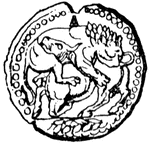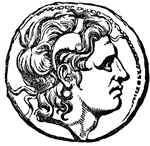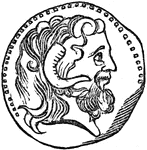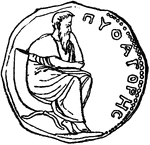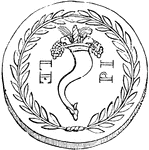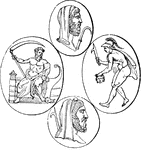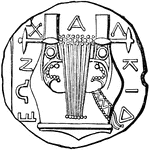This Greek ClipArt gallery offers 87 illustrations of historic coins of Greece.

A Ship
A ship on the acrostolium of which hangs a shield, an emblem of the mercantile and warrior city of Tyre.…

Alexander the Great
A medal with the portrait of Alexander the Great on one side; the other side shows the inscription ALEXANDROU…
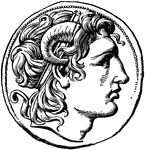
Coin of Alexander the Great
Alexander the Great's head on a silver coin of Lysimachus in 321-281 B.C.

Coin of Alexander the Great
"Coin of Alexander the Great. Alexander, at the time of his father's death, was in his twentieth year,…

Aphractus
"Called also navis aperta, a ship which had no deck but was merely covered with planks in the front…

Aplustre
"An ornament of wooden planks, which constituted the highest part of the poop of a ship. From the representations…

Apollo
Apollo, the god of day, his head surrounded by rays. His chariot bears similarities to a rainbow. It…

Aurum
"Gold appears not to have been coined at Athens till the time of the Macedonian empire, with the exception…
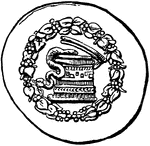
Cistophorus
The front of a Greek silver coin weighing on the average around 193 grains, first issued by the kings…
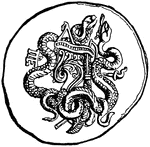
Cistophorus
The back of a Greek silver coin weighing on the average around 193 grains, first issued by the kings…

Coin of Cypress
A coin of Cypress, representing the temple of Venus. It shows that she was worshiped in this island…

Coin of Paphos
A coin of Paphos, now Baffo, in the island of Cypress. It shows that Venus was the deity worshiped there…

Isthmian crowns
"The Nemian and Isthmian games occurred more frequently than the Olympic and Pythian. They were celebrated…

Damareteion
The coin was first struck in commemoration of the gold crown sent by the Carthagininians to Demarete.…
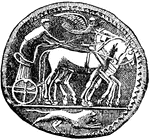
Damareteion
The coin was first struck in commemoration of the gold crown sent by the Carthagininians to Demarete.…

Drachma
"The principal silver coin among the Greeks. The two chief standards in the currencies of the Greek…

Drachma
"The principal silver coin among the Greeks. The two chief standards in the currencies of the Greek…
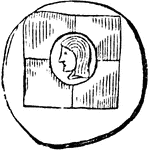
Encased Coin
"The surrounding of the punchmark with a band bearing a name, and the introduction of a head in its…
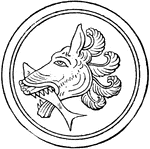
Episemon
Episema were used in Greece as a symbol for a country, region, or used on a shield or badge. This episemon…
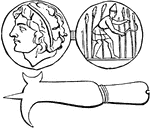
Falx
"A sickle; a scythe; a pruning knife or pruning hook; a bill; a falchion; a halbert. As culter denoted…
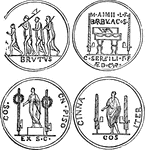
Fasces
"Rods bound in the form of a bundle, and containing an axe in the middle, the iron of which projected…

Obverse and Reverse Sides of a Gazzetta
"Gazzetta of the Ionian islands, 1801. A small copper coin, worth about 3 farthings, made in Venice…

Greek Coin
"In the reign of Philip of Macedon, the coinage of Greece had attained its full development, having…

Isthmian Games
This medal commemorates the Isthmian Games, celebrated on the Isthmus of Corinth in honor of Neptune.…

Jupiter
A medal engraved with the image of Zeus, or Jupiter, next to a sphinx; the other side of the coin depicts…
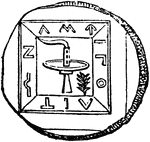
Lampadephoria
"Lampadedromia, torch-race, and often simply, Lampas, was a game common throughout Greece. At Athens…

Medal
A medal showing five cities, represented by female figures, offering fruit to a goddess sitting on a…

Medal of Attalia
A medal of Attalia. One side pictures Neptune with his trident, suggesting that Attalia was a seaport.…

Medal of Caesarea Libanus
A Medal of Caesarea Libanus. On one side the head of Alexander Severus is engraved. Depicted on the…

Medal of Corinth
The medal of Corinth. On one side the Chimera with the inscription Korinthion is engraved. On the other…

Medal of Crete
A medal of Crete, representing a Minotaur and the labyrinth in which he was confined.
